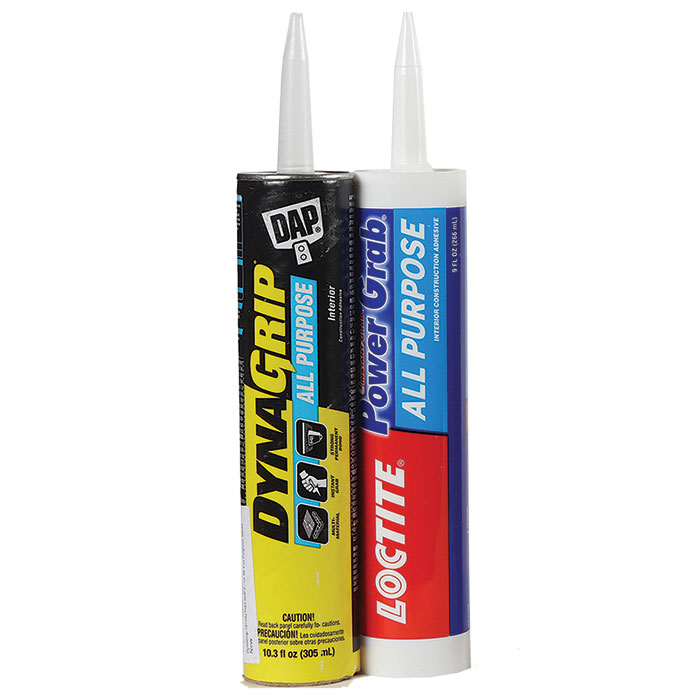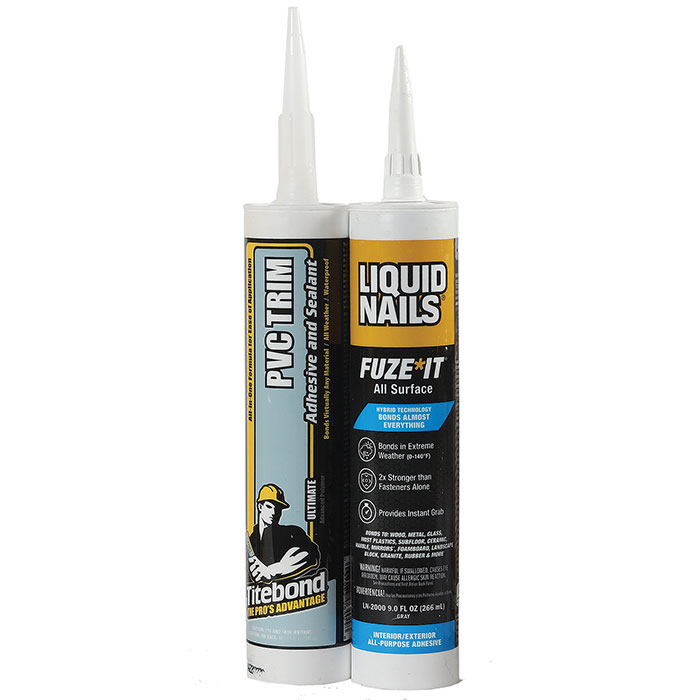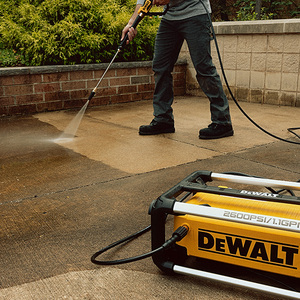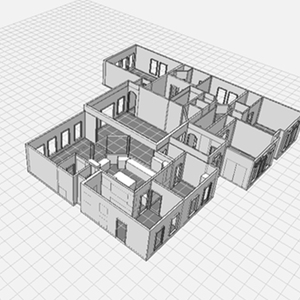Choosing The Right Construction Adhesives
Understanding the different types of adhesive available and when to use each is your best strategy to achieving the strongest, safest, and longest-lasting bonds.

Synopsis: Builder Randy Williams gives an overview of the five major types of construction adhesive, when to choose each type, and methods of application.
For hundreds of years, adhesives were created with organic compounds made from animal parts and natural resins for wood joinery, book binding, and other tasks requiring materials and surfaces to be bonded together. Today, most construction adhesives are made with synthetic acrylic resins, polyurethane monomers, hexane, and other nonpolar solvents, all man-made compounds.
Modern adhesives are used extensively by manufacturers, builders, and homeowners, and some form of them can be found in nearly every product around you. While adhesives are available in buckets, sticks, drums, tubes, cartridges, and more, this article will concentrate on the fluid adhesives often used in construction and commonly found at hardware stores, lumberyards, and home-improvement centers; the differences between them; and how each should be used.
Choosing the right adhesive
You can’t choose the best adhesive without first knowing the difference between adhesives, caulks, and sealants. The purpose of caulks and sealants is to bridge a gap between two surfaces. Caulks tend to be a cosmetic solution, making the joint look good at a low cost—think painter’s caulk. Sealants, on the other hand, will stop air, water, or other unwanted elements from passing through a joint. Sometimes these purposes are combined when the seal needs to both look good and perform. Caulks and sealants typically have lower-strength bonds but high flexibility. Adhesives are engineered to hold two or more surfaces together. Because of this, they have higher bond strengths than caulks and sealants and are usually less flexible.
The types of materials you are trying to bond together will have the largest impact on which construction adhesive you choose, because no one type will work for every project. Some adhesives work great on porous surfaces like wood, OSB, drywall, plaster, or concrete, but would be a poor choice for nonporous surfaces like plastic, metal, glass, ceramic, and foam.
There are other considerations as well, such as the environmental conditions you’re working in, the strength of the bond needed, the budget, chemical compatibility, and the importance of volatile organic compound (VOC) compliance. Manufacturers are doing a good job at identifying which product is recommended for a specific application and some even make products for very specific tasks, including DAP’s Dyna Grip Mirror, Marble, Granite and Titebond’s Greenchoice Drywall construction adhesives.
Construction adhesive: Five formulations to choose from
ACRYLIC, OR WATERBASED ADHESIVES have lower odor and VOC levels, making them ideal for indoor use. The adhesive cures by evaporation, limiting their use to at least one porous substrate. Curing by evaporation will be very slow or possibly nonexistent when trying to join two nonporous surfaces like glass or PVC. This evaporative curing process also causes shrinkage of the product during the cure. Because of the water in the product, application temperatures will need to remain above freezing during the entire curing process.
SOLVENT-BASED ADHESIVES have two categories, the traditional solvent-based products that contain high-VOC solvents and the newer, VOC-compliant products required in California and other areas in North America. These adhesives can be applied in colder temperatures and may still be effective when the surfaces are wet or frozen.
The original solvent adhesives have strong odors and can affect air quality as they cure, which in some cases can take up to 60 days. For this reason, they are recommended for exterior use only. Similar to water-based adhesives, curing results in shrinkage due to evaporation of the solvent. They are not recommended for use with solvent-sensitive materials like polyethylene (plastic sheeting), polypropylene (plastic resins), or polystyrene (foam insulation) based materials.
The VOC-compliant solvent-based adhesives have many of the same characteristics as the older solvent-based products, but there are a few differences. Because these adhesives are somewhat water soluble, they have a slightly smaller range of environmental conditions where they can be used, and the solvents used tend to evaporate quicker. The VOC-compliant products also have a smell similar to nail polish remover, which can be unpleasant to some. Because both types of solvent-based adhesives cure by evaporation, they require at least one substrate to be porous.
POLYURETHANE-BASED ADHESIVES chemically cure, meaning there is no loss of mass or shrinkage. Polyurethane-based adhesives bond to both porous and nonporous surfaces and can be applied in freezing and hot temperatures. These adhesives set quickly but most allow for some adjustment before they fully cure. They can also be used both indoors and outdoors. Polyurethane adhesives can expand slightly as they cure, which can be a problem when bonding some materials and can also be a problem for people that have sensitivities to urethane chemicals, specifically isocyanates. Polyurethane-based adhesives are the best choice for bonding weather-resistant OSB, but are not recommended for use with rigid polystyrene.
HYBRID POLYMER ADHESIVES are the best of two worlds. They can perform as both an adhesive and sealant and can be applied in both very cold and very warm environments. Like polyurethane-based products, hybrid adhesives cure chemically, but unlike polyurethanes, they do not expand as they cure, and they work well in PVC joinery, or when needing to bond two nonporous surfaces. Hybrid adhesives have both good flexibility and good bond strength, though the bond is not as strong as some of the other adhesives. Hybrids are not recommended to be used on some rubber or flexible sheet goods.
FOAM ADHESIVES were initially introduced primarily as a subfloor adhesive, but are becoming popular for projects like drywall installation and are being used more frequently on more conventional projects normally reserved for traditional adhesives. The foam dispenser makes applying the adhesive to joists and trusses faster and easier than a traditional caulkinggun application. The adhesive is polyurethane-based and comes out of the can nozzle as a foam, but quickly collapses. Manufacturers claim that one can of foam adhesive is equal to at least eight similarly sized tubes of traditional adhesive. Foam adhesives may not be the best choice if you need to bridge gaps between uneven surfaces, and as with all polyurethane products, people with sensitivities to urethane chemicals, specifically isocyanates, may experience breathing problems if not protected when working with this type of adhesive.

Begin with surface prep, end with a strong cure
To create the strongest bond, you need to prepare the surfaces. For instance, Titebond states in each technical data sheet (TDS), “surfaces must be clean and free of any material that may prevent adequate adhesion.” DAP requires the same conditions but adds “structurally sound” to the requirements. Long story short, it’s important to remove any lose debris or dust. I would also make sure that there is no oil or other substance that may affect the bond between materials. Other recommendations will depend on the adhesive being used and the substrates being bonded. Manufacturers will have limited instructions on the adhesive cartridge or bucket, but more information can be found on the manufacturer’s TDS, usually available on their website.
Curing is the process of setting up or hardening by way of a chemical reaction. The time needed for an adhesive to cure will depend on the type of adhesive used, the working temperatures, and the humidity levels, along with the quantity of adhesive used. A fully cured adhesive will not be tacky, and will become hard to the touch.
Water-based and solvent-based adhesives cure when the water or solvent evaporates out of the adhesive. This evaporation only happens through a porous surface, which means these types of adhesives are not meant for joining two nonporous surfaces, like glass Typical working time for water- and solvent-based adhesives is 10 to 15 minutes with a full cure taking up to seven days.
Both polyurethane and hybrid polymer adhesives, on the other hand, begin their curing process with moisture. As long as one of the bonding surfaces has some moisture, the moisture will start a chemical reaction to cure the adhesive. Moisture in the air can also start the chemical reaction. When bonding two nonporous surfaces, or when humidity levels are below 30%, adding some moisture to the applied adhesive by misting with a spray bottle is recommended. Be aware that adding moisture will shorten the working time from about 20 minutes to less than 15 minutes. Full cure for these adhesives typically takes two to seven days.
Construction adhesive: Four options for application
When it comes to applying adhesives, the go-to method is still the classic 10-oz. and 28-oz. caulking guns, but expect to see more foam applicators and sausage guns at a job site near you. The advantage of a sausage-tube cartridge is that there’s very little container waste produced. When the cartridge is empty, all that’s left is a small cookie-sized piece of foil. When using foam applicators, it’s best to hold the tip just above the surface instead of dragging it along while dispensing. Battery-operated tools are available for both the traditional tubes and the sausage cartridges. They can greatly reduce hand and wrist fatigue when you have large quantities of adhesive to apply.

When bonding large materials together, such as installing a subfloor over floor trusses or attaching stair treads to stringers, you want a larger quantity of adhesive to maximize the bond between the substrates. This is best accomplished by cutting the tube nozzle straight, rather than at an angle. This type of nozzle cut will allow a large, round bead that will have the smallest ratio of surface area to volume; that center of the bead will dry much slower than the outside, providing a longer “open” working time.

Installing a few round beads of an adhesive is sometimes all that is needed. Often this is the method of choice when installing lighter-weight decorative panels to walls. These panels should be rigid enough not to show bumps where the adhesive is placed. Coverage of an adhesive will depend on the size of the bead. A 10-oz. tube of adhesive using a 1 ⁄ 8-in. bead will supply 129 lin. ft. of adhesive. That same 10-oz. tube with a 1 ⁄ 2-in. bead will reduce coverage to only 8 lin. ft. Coverage charts can be typically be found in technical data sheets from the manufacturer.

Adhesives have a shelf life
Anyone who has ever broken a caulk gun trying to force out old adhesive from a tube knows the stuff can go bad, and once it cures in the tube, it’s going to end up in the landfill. When it comes to applying adhesives, the go-to method is still the classic 10-oz. and 28-oz. caulking guns, but expect to see more foam applicators and sausage guns at a job site near you. The advantage of a sausage-tube cartridge is that there’s very little container waste produced. When the cartridge is empty, all that’s left is a small cookie-sized piece of foil. When using foam applicators, it’s best to hold the tip just above the surface instead of dragging it along while dispensing. Battery-operated tools are available for both the traditional tubes and the sausage cartridges. They can greatly reduce hand and wrist fatigue when you have large fill. Most adhesives will have a shelf life of anywhere from six months to two years, but like the milk in your refrigerator, the product may not be bad on the day of its expected expiration. How long it takes the product to cure inside the container is largely affected by how it’s stored. Most manufacturers recommend storage in a cool, dry location. I’ve learned to gather all my adhesives, sealants, and caulks in the fall of the year and move them to my basement to keep them from freezing inside a job-site trailer or vehicle.
There are manufacturer codes printed somewhere on every tube of adhesive, usually found either on the plunger or around the top of the container. For example, I have a tube of Titebond’s Fast Set; the code printed on the plunger cap is A190807054. The “A” indicates that the product was manufactured in America; “19” is the year of manufacture, “08” is the month, and “07” is the day (so August 7, 2019). The last three numbers are the sequential lot number of the product. At the time of writing, it was 36 months old, and the expected shelf life of this particular adhesive according to the manufacturer is 18 months. Just to see if it was expired, I opened the tube and squeezed out some of the adhesive using a manual caulk gun. It gunned easily and was still sticky. I would not have any reservations using this 36-month-old adhesive on any of my jobs. It may be a good idea to become familiar with the numeric coding of the adhesive you use, so you can rotate your stock and use the oldest products first.
In researching construction adhesives, I contacted Bob Behnke from Franklin International, the manufacturer of Titebond. I asked him what we’re doing wrong as an industry when it comes to working with adhesives.
This was his reply: “Always follow the directions on the label and technical data sheet. It’s very important to understand what substrates are being bonded and to choose the correct adhesive for the application. There is no one product that can bond all substrates.”
All the manufacturers I researched have workable websites; most have phone lines dedicated to helping customers choose and work with construction adhesives. The next time you need to secure a loose stair tread or glue up two pieces of PVC trim, don’t grab whatever’s in the van, do some research and use the right adhesive for the job.
– Randy Williams is a builder and energy auditor in Grand Rapids, Minn.
Photos by Mark Petersen, unless otherwise noted.
From Fine Homebuilding #312
RELATED STORIES
- Choosing the Right Construction Adhesives and Sealants
- Remodel With Confidence Using Loctite Construction Adhesive
- Choosing the Right Construction Tape for the Job
Fine Homebuilding Recommended Products
Fine Homebuilding receives a commission for items purchased through links on this site, including Amazon Associates and other affiliate advertising programs.

Large-Capacity Lightweight Miter Saw

Heat-Shrink Tubing
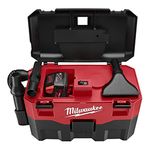
Milwaukee Cordless Shop Vac (0880-20)
